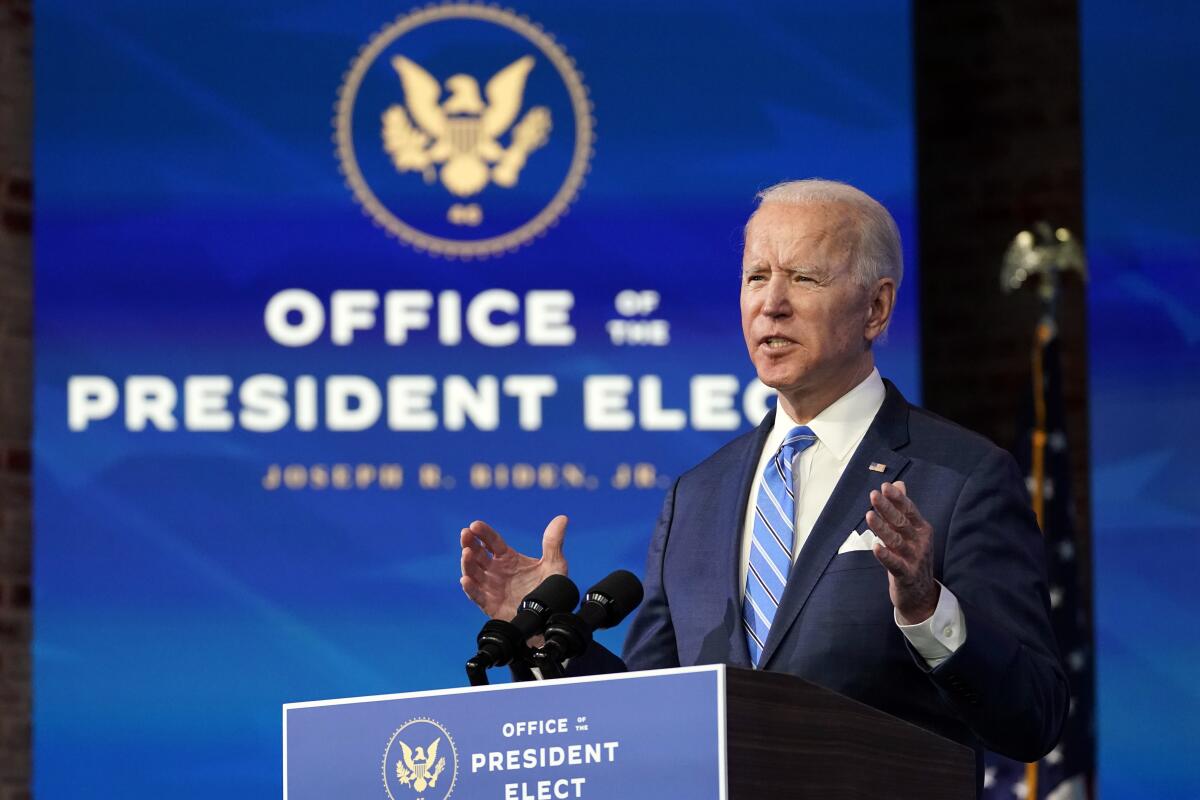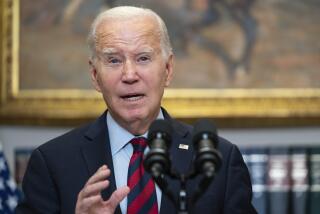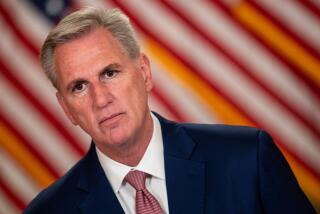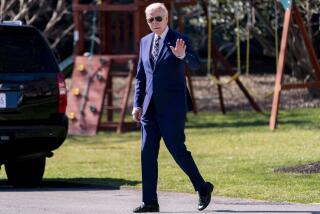Biden proposes $1.9-trillion plan for pandemic and economic crisis

WASHINGTON — President-elect Joe Biden proposed a $1.9-trillion plan to combat the nation’s economic and public health emergencies, as he began to raise the curtain on a new administration built on faith in the power of the federal government to help solve problems.
In a speech to the nation Thursday night, Biden called for quick congressional action on his sweeping package, which will include steps to speed production and distribution of vaccines, an additional $1,400 in direct payments to individuals, an increased minimum wage, expanded unemployment benefits, aid to state and local governments and an expansion of aid to families with children.
“We have to act and we have to act now,” Biden said. “The very health of our nation is at stake.”
He cast the plan as an immediate response to a continuing pandemic and an economic crisis that is worsening as already high unemployment rates have once again started to rise after months of declines from record levels in the spring.
Many of the proposals, however, also serve as down payments toward longer-run Democratic goals, including a one-year expansion of aid to families with children, which Biden said would “cut child poverty in half” over the next year.
The effort to do both comes with a big price tag — more than twice the $908 billion in relief Congress approved last month. That will make it a tough sell in a narrowly divided Senate where Republicans have tremendous power to slow or block legislation even though Democrats will hold the majority.
But Biden argued that spending now would put the economy on a sounder foundation for renewed growth.
“I know what I just described does not come cheaply,” he said. “But failure to do so will cost us dearly.”
A senior Biden official said the president-elect and his aides hoped that his speech would begin to build public support for the plan.
“The strategy is to make the case clearly to the American people about the immediacy of the need, and to work to try to build on the spirit of bipartisanship that helped to bring together action in December,” the official said, referring to the relief approved last month. “But that was just a down payment. And so we’re going to need to work to do more.”
Reflecting Biden’s view of the plan as just a first installment, officials referred to it as a “rescue” package designed to address the most urgent needs, to be followed next month by a “recovery” plan that will address his more ambitious goals beyond getting back to “normal.”
Biden said he would lay out that next stage, which is expected to include his infrastructure plan and measures to combat climate change, during a speech to a joint session of Congress next month.
The plan drew quick support from top Democrats.
“When President-elect Biden was elected, he told the American people that ‘Help is on the way.’ With the COVID-rescue package the president-elect announced today, he is moving swiftly to deliver that help,” House Speaker Nancy Pelosi (D-San Francisco) and Senate Democratic leader Charles E. Schumer of New York said in a statement before Biden’s speech.
But the opening act of the incoming Biden administration will pose a tough test of his oft-repeated goal of building bridges to the Republican Party and bringing the spirit of bipartisanship back to Washington. He is proposing a big expenditure just as Republicans, after ignoring the run-up of deficits under President Trump, have expressed concern about the growth of government spending and questioned the need for more relief so soon after last month’s action.
A key question is whether Biden will treat it as an opening bid from which he will retreat to build bipartisan support, or try to push it through the Senate with Democratic votes alone.
“Is he willing to meet Senate Republicans — at least some of them — where they are?” asked Rohit Kumar, a former deputy chief of staff to Senate Republican leader Mitch McConnell of Kentucky who is now co-leader of PwC’s National Tax Office. “That probably doesn’t include increasing the minimum wage to $15 an hour.”
The Biden plan included some proposals, such as aid to state and local governments, that Republicans resolutely opposed in previous negotiations. It is a wish list that reflects his desire to act boldly, perhaps sensitive to complaints that the Obama administration’s 2009 economic stimulus plan was too cautious for the crisis inherited from George W. Bush.
“The risk of doing too little at this moment is much greater than the risk of doing too much,” said the senior Biden official, who briefed reporters under ground rules that did not allow names to be used.
Biden’s drive for bipartisan support, if successful, would be opposite the experience of his recent predecessors on major economic initiatives. No Democrats voted for Trump’s 2017 tax cut. President Obama’s 2009 economic relief act passed with no GOP votes in the House and just three from Republicans in the Senate. Before him, Bill Clinton in 1993 had to rely solely on Democrats to pass a deficit reduction bill that was a signature element of his presidency.
The centerpiece of the Biden plan is the effort to speed up vaccinations and expand coronavirus testing. In his speech, Biden said the Trump administration’s efforts had been “a dismal failure so far.” Deaths nationwide due to COVID-19 are nearing 400,000.
Biden plans to ask for $400 billion to speed the pace of vaccinations and meet his goal of inoculating 100 million people within the first 100 days.
His plan would expand coronavirus testing and create community vaccination centers around the country, as well as mobile units to serve people in remote communities and other hard-to-reach groups. The legislation would also ensure that all U.S. residents, including those in the country without legal status, would be able to be vaccinated free of charge.
The expanded testing is “critical to getting kids back to school” and for protecting workers, said another senior Biden official. The testing would also significantly improve the ability to detect new strains of the virus, the official said, noting that the U.S. ranks 43rd in the world in its capacity to do the gene sequencing needed to see if the virus is mutating.
Roughly $130 billion would be aimed at getting schools reopened nationwide. School districts could use the money to reduce class sizes, improve ventilation of school buildings, buy more protective equipment for teachers and other staff and provide summer school programs for children who have fallen behind over the last year.
The overall plan also includes roughly $1 trillion in payments to individuals and families, including a new round of $1,400 per-person relief checks, and about $440 billion in help for local governments and businesses.
Biden also plans to ask Congress to nearly double the federal minimum wage to $15 an hour, a major goal of progressive and labor groups.
He noted that voters in Florida, a state he lost to Trump, had approved a $15 minimum wage in a referendum in November. “The rest of the country is ready,” he said.
The plan includes a series of short-term measures to provide economic aid to families; the Biden administration eventually is likely to try to make them permanent.
One part of the plan would in effect create a national family allowance for the first time in the United States. The proposal would temporarily expand the existing federal child tax credit and make it fully refundable, meaning that families that don’t owe taxes would get the money in the form of a government payment.
That “would greatly benefit the poorest kids in the United States,” reaching about 27 million children who aren’t helped now because their families are too poor to make use of a tax credit, said Katherine Michelmore of Syracuse University, who has studied the impact of the existing program. “Over half the kids who would benefit are Black and brown children,” she said.
Although his plan would expand the tax credit only for one year, Biden backed a long-term expansion during his campaign.
The proposals are “emergency relief measures” now, but over time, “one hopes they will turn into permanent reforms,” said Gene Sperling, who headed the White House National Economic Council under Presidents Clinton and Obama. “For a country that should want to reduce child poverty, it doesn’t make sense that 35% of kids don’t benefit from the child tax credit” because their families are too poor.
The proposed new round of payments for individuals would be on top of the $600 approved by Congress, bringing the total to $2,000. The demand for $2,000 payments had been a major part of the Democrats’ successful campaign to win two Senate seats in Georgia in runoff elections this month. The idea has also drawn support from some Republicans, including Trump.
In addition to those payments, the plan would extend a number of income-support programs through the end of September, several of which are set to expire in March. Biden would also make the existing programs more generous.
Those include a requirement that companies provide paid sick leave for workers, with the government paying to cover wages of up to $73,000 a year. That would cover more than three-quarters of the U.S. labor force, Biden aides said.
Biden would also expand food aid, including the Supplemental Nutrition Assistance Program, also known as food stamps, and the Women, Infants and Children program.
The proposal would also extend additional weeks of emergency unemployment benefits and provide a $400 weekly federal supplement on top of existing state unemployment payments. Congress included a $600 federal supplement in its original coronavirus relief package in the spring, but it was strongly opposed by most Republicans, who said it would encourage people to stay on unemployment rather than going back to work.
Biden would also extend the moratorium on evictions and foreclosures and provide $30 billion in rental assistance to help renters and small landlords.
More to Read
Get the L.A. Times Politics newsletter
Deeply reported insights into legislation, politics and policy from Sacramento, Washington and beyond. In your inbox three times per week.
You may occasionally receive promotional content from the Los Angeles Times.












